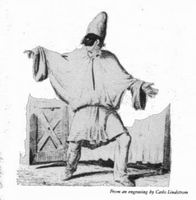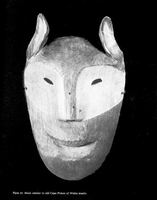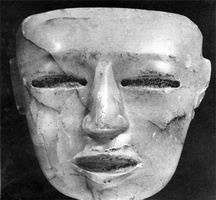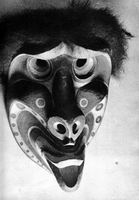On Masks
An Exploration in Myth and Magic
by Nathan Kibler
Common sense says a mask covers and hides true identity. After all, masks are tools of criminals, spies, thieves and anyone else wanting to deceive. But in Western society, we find masks are primarily the domain of actors.
An actor assumes an identity by wearing the masks of costume and makeup.
They engage you in their story telling with these tools. Their purpose
is not so much to deceive the mind, but to trick the eye so that their
higher purpose is revealed: unmasking the inner self. Only then does theater
have the magic to seduce us into suspending our disbelief and engaging
us in the actor's message.

|
Commedia Del'arte Character,
Punchinello
|

|
Cover, The Mask, DVD
|
In the movie The Mask, starring Jim Carrey, mild mannered bank clerk, Stanley Ipkiss, learns the true power of masks when he inherits one with supernatural powers. This mask exaggerates his innermost desires to very comedic extremes whenever he wears it. The mask's powers, interestingly enough are attributed to the Norse trickster god, Loki.
Loki is a trickster god who was neither benevolent nor benign, causing chaos and mayham by giving those who asked exactly what they wanted but in a manner they did not expect. There are many parallel trickster gods in other cultural legends. Coyote, Raven and Sasquatch of North America, Esu and Legba of Voodun, Hermes (Mercury) and Faunus (Pan) of Greek/Roman legend, Susa-noo-o and Kitsune of Japan, and of course, the ultimate trickster from India, Hanuman, the monkey god who helps rescue the wife of Prince Rama in the Ramayana by setting fire to everything with his tail when he is burned as a punishment.
The mask is the symbol of the trickster god because it reveals our innermost desire to create power for ourselves. In ancient times, masks were not viewed as disguise as much as they were viewed as the embodiment of the god. A priest or priestess wore masks as a way to represent the god or spirit worshiped.

|
Bali, Mask of Hanuman,
the monkey god
|

|
Native American, Cape
of Prince Wales
|
Shaman are usually viewed as spiritual healers who wear masks in order to frighten the spirits plaguing their patients. But shaman also wear masks to dramatize the tales of the spirit's exploits. Masks are a way for a shaman to take on the personality and qualities of that particular spirit or god.
Many modern day heroes wear masks to universalize their appeal by concealing their identity and enhancing their mystery. Characters like Batman, Spiderman, and The Lone Ranger have entered popular culture wearing masks that not only conceal their identity but also inform the viewer what they represent. Batman wears noble bat ears, Spiderman wears ensnaring webbing and the Lone Ranger wears the Domino, a traditional mask that indicates hidden purity and virtue. Rock Stars like David Bowie, Elton John and the band Kiss, have all utilized masks to enhance the archetypal aspects of their stage persona.

|
Mezo American, Ecuador
|

|
Native American, Kwakiutl
|
Often people hide behind masks without realizing how those masks define them. Clothing, beards, glasses, and the images of popular culture are masks that inadequately hide us from observation. Being aware of what we hide behind is the first step to understanding the role masks play within our society today. Masks represent symbols, which in turn represent essential ideas. People often try on these ideas to identify with a particular section of society without exploring how wearing those ideas effect them and hinder their ability to work outside of their identified group.
Ultimately we choose the identities and masks we wear. Learning their meaning and effect in our society is the first step to understanding ourselves and how we interact with our environment. Stripping away those masks and revealing our inner self is the only way we can truly connect with each other.
Writings | Gallery | Bibliography